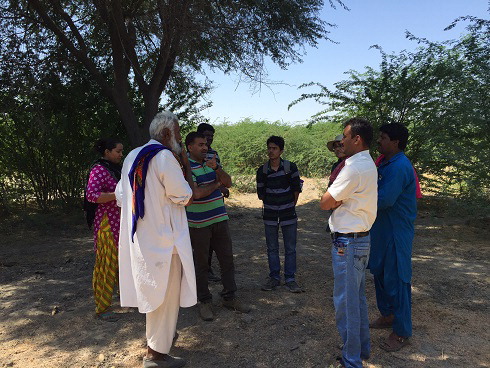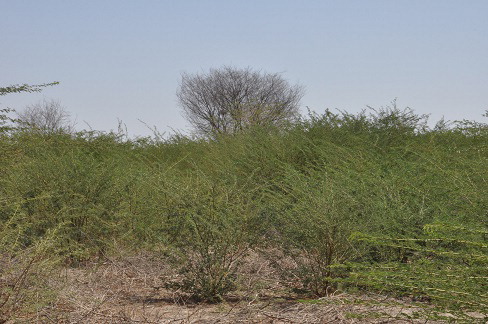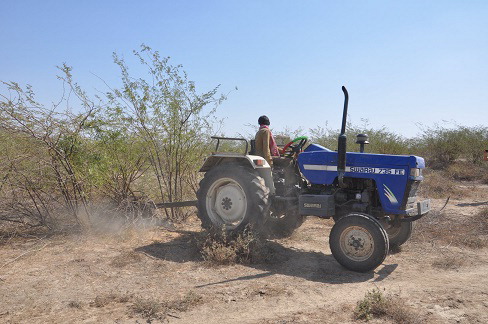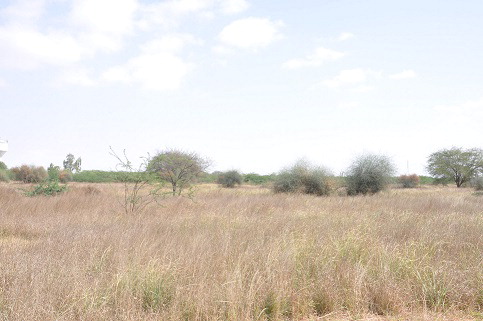|
Cycle 4 (2015 Deadline)
The Banni grasslands in a time of change: Ecological and socioeconomic resilience in a coupled human-natural system
PI: Ankila Hiremath, Ashoka Trust for Research in Ecology and the Environment (ATREE)
U.S. Partner: Susan Cordell, USDA-Forest Service Institute of Pacific Islands Forestry
Project Dates: December 2015 - September 2021
Project Overview Karayal Ecosystem Restoration Video
Dahar Livelihoods Video

PEER Banni team: The project team at a potential experimental site with a Maldhari elder (photo courtesy of Dr. Hiremath). |
India’s unique ecosystems, like Banni, Asia’s largest tropical grassland in Gujarat’s arid Kutch District, are facing increasing vulnerability. Banni, historically home to 22 pastoralist communities of the Maldharis and rich in biodiversity, including migratory cranes and flamingoes, has undergone significant transformation in recent decades. Pastoralism has shaped Banni's landscape, with unique breeds like the Kankrej cow, Banni buffalo, and Kharai camel. Banni's challenges are exacerbated by attitudes that view arid grasslands as wastelands fit for conversion to carbon-sequestering forests, wind and solar farms, or industrial estates. A key driver of change is Prosopis juliflora, an introduced nitrogen-fixing tree that now covers nearly half of Banni. While seen by some as successful land reclamation, P. juliflora has displaced native flora, altered habitats for wildlife, and reduced grazing areas for livestock. Its spread has also fostered a charcoal economy, profoundly impacting pastoral livelihoods and cultures. This project aimed to understand the dynamics of P. juliflora spread under climate change scenarios, assess its ecological impacts, and evaluate management options for enhancing Banni's ecological and socioeconomic resilience. Insights gained into the ecological impacts of P. juliflora, feasibility of grassland restoration, and sustainability of charcoal harvesting informed the development of adaptive management scenarios. The Maldharis of Banni, leveraging their traditional knowledge and supported by this project, have sought community rights to manage and conserve their landscape under the Forest Rights Act of 2006. This legislation empowers local communities to sustainably manage landscapes they have customarily used. By diversifying livelihood options through this PEER project, Banni's Maldharis aim to reduce vulnerability to climate change while enhancing carbon stocks and sustaining pastoral traditions. This initiative not only benefits Banni but also serves as a potential model for similar landscapes worldwide, aligning with USAID’s Feed the Future efforts..
Summary of Recent Activities
The original objectives of this project were (1) to understand patterns of Prosopis juliflora distribution and spread; (2) to understand the ecological impacts of Prosopis and evaluate the feasibility of grassland restoration for livestock and wildlife; and (3) to understand dynamics of Prosopis harvest for charcoal and assess livelihood implications of different management scenarios. Under the supervision of PI Dr. Ankila Hiremath and other senior researchers, graduate students and postdoctoral scholars had the opportunity to play important roles in the project. Towards the first objective, postdoctoral associate, Madhura Niphadkar worked on mapping Prosopis, using a comparison of different remote-sensing sensors. Niphadkar also helped the team reconstruct soil salinity maps for the Banni from 1989, and recently (2014), using secondary data sources. The researcher team subsequently used the data to test their hypothesis regarding the possible association of Prosopis spread with increasing salinity.
A major focus of the team’s work has been on trying to understand the impacts of Prosopis and the feasibility of grassland restoration, the second objective. PhD student Chetan Misher’s work was on the impacts of Prosopis on wildlife habitat and especially how that affects the behavior and habitat use by canids and their prey species. At the time the final PEER project report was submitted in January 2022, one paper arising from Chetan’s work had been published and another was under review. With collaborator Dr. Sonali Saha, Dr. Hiremath and her colleagues also worked on a comparison of water use characteristics and salinity tolerance of Prosopis and native woody species, using nursery experiments and in situ measurements, to understand why Prosopis appears to have a competitive advantage over other species. They also investigated the ecohydrological impacts of Prosopis on water table depth and salinity, using wells installed in experimental plots that they set up across the Banni. That manuscript was being revised at the time of the final report.
Ashish Nerlekar worked with the PEER team on their experimental Prosopis removal (and control) plots to determine the relative efficacies of uprooting and lopping as methods to restore grassland. This work was published in Restoration Ecology. Postdoctoral associate Nirav Mehta used the experimental Prosopis lopping plots, in association with Prosopis allometric equations that the team derived, to try to understand the dynamics of Prosopis lopping for charcoal, a part of the group’s third objective. PhD student Ramya Ravi’s work examined Prosopis charcoal-making, as well as other dependencies on Prosopis, and how the tree contributes to people’s livelihoods. Her work suggests that Prosopis may have irreversibly transformed Banni into a novel social-ecological system and encourages one to think of restoration using a broader socioconomic and cultural lens, rather than a purely ecological one.
Other key collaborations that this project enabled were with filmmakers from Srishti Films and system dynamics modelers Mihir Mathur and Kabir Sharma of DESTA. The collaborators from Srishti Films created two short videos, one on the ecological impacts of Prosopis and the other on the socioeconomic impacts of Prosopis in the Banni (see links above). Both films were sensitively made, given the filmmakers’ long association with the landscape, and are an evocative and extremely effective means of communicating the work of the project to a larger audience.
The collaboration with Mathur and Sharma was enabled by a PEER Evidence-to-Action supplement to the base PEER grant. Mathur and Sharma created a system dynamics model of the Banni using data the team generated and inputs received through a series of participatory workshops with members of the Banni community, staff of the local partner organization Sahjeevan, and project members and other researchers. The model integrated the biophysical and socioeconomic systems of Banni to explore different management scenarios and was designed as an insight-builder tool. They then created an Android app that served as a user-friendly interface with the model. Dr. Hiremath and her team were able to take the app back to the communities to initiate a dialogue on potential management options for the Banni, including under scenarios of future climate change.
Apart from these outreach tools, which have been very helpful in sharing the researchers’ work with stakeholders and larger audiences, there have also been opportunities to share the findings more formally, e.g., in modules offered as part of a training program conducted by Sahjeevan in collaboration with Kutch University. In addition, the team’s experimental work on grassland restoration has served as a model to be scaled up, and Sahjeevan has initiated larger scale Prosopis removal and grassland restoration interventions across the Banni in collaboration with the local communities. The Forest Department has also indicated that they would like to work with Dr. Hiremath and her colleagues in formulating their working plan for the landscape.
COVID had an impact on the project and required additional no-cost extensions, in particular to enable Chetan Misher to complete his field work in Banni. Unfortunately, however, it was impossible to hold the planned final project dissemination workshop bringing all of Banni’s stakeholders together. Even after the COVID-related lockdowns were lifted, the dynamic nature of the relationship between Banni’s communities and the Forest Department and certain tensions that had arisen caused the workshop to be cancelled. Because of the state of flux and uncertainty in the landscape related to governance and community rights, Dr. Hiremath reports that she and her colleagues are turning their focus now that the PEER project has ended to a book about the Banni. This will synthesize their learnings from the PEER project, as well as work by other researchers in the landscape, over the past decade.
In Memoriam
The PEER team would like to pay tribute to two people who were a crucial part of their work in Banni but who passed away during the course of the project. The first, Salim Node (Salim Mama, as he was called) was a respected Banni elder who was keenly involved in the project, helping with inputs to the experimental design, helping the team think through questions relevant to the communities in Banni, and providing them with unstinting support. The other, Nirav Mehta, was a valued colleague. As the postdoc based in Banni, he coordinated all the field work and data collection. He will be greatly missed, though his work lives on.
Publications
A.N. Nerlekar, N. Mehta, R. Pokar, M. Bhagwat, C. Misher, P. Joshi, and A.J. Hiremath. 2021. Removal or utilisation? Testing alternative approaches to the management of an invasive woody legume in an arid Indian grassland. Restoration Ecology e13477. https://doi.org/10.1111/rec.13477
C. Misher and A.T. Vanak. 2021. Occupancy and diet of Indian desert fox Vulpes vulpes pusilla in a Prosopis juliflora invaded semi arid grassland. Wildlife Biology 2021(1): wlb.00781. https://doi.org/10.2981/wlb.00781.
Ramya Ravi and Abi T. Vanak. 2019. Why has drought hit the Maldharis of Kutch so hard this year? Popular article in The Hindu https://www.thehindu.com/sci-tech/energy-and-environment/drought-in-a-desertwhy-has-drought-hit-the-maldharis-so-hard-this-year/article27090863.ece
 |  |  | | The full cycle showing Prosopis juliflora choking a Banni grassland, the harvesting of Prosopis juliflora for charcoal-making, and a restored grassland following its removal (photo courtesy of Dr. Hiremath). |
Articles about Project
How to save Banni grasslands from invasive species? Here’s what a new study suggests. Rishika Pardhikar. August 5, 2021. https://www.downtoearth.org.in/news/wildlife-and-biodiversity/how-to-save-banni-grasslands-from-invasive-species-here-s-what-a-new-study-suggests-78298
Large-scale removal of Banni’s invasive "mad tree" Prosopis is not the solution: study by Sahana Ghosh. August 3, 2021. https://india.mongabay.com/2021/08/large-scale-removal-of-bannis-invasive-mad-tree-prosopis-is-not-the-solution-study/
Are we overlooking the role of grasslands in mitigating climate change? by Aathira Perinchery. June 29, 2021. https://india.mongabay.com/2021/06/are-we-overlooking-the-role-of-grasslands-in-mitigating-climate-change/
Back to PEER Cycle 4 Grant Recipients
|







